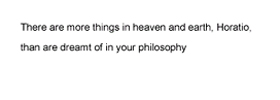In order to use PHP's PDF manipulation capabilities, you need to have the PDFLib library installed on your system. If you're working on Linux, you can download a copy from http://www.pdflib.com/pdflib/index.html and compile it for your box. If you're running Windows, your job is even simpler - a pre-built PDF library is bundled with your distribution, and all you need to do is activate it by uncommenting the appropriate lines in your PHP configuration file.
Additionally, you'll need a copy of the (free!) Adobe Acrobat PDF reader, so that you can view the documents created via the PDFLib library. You can download a copy of this reader from http://www.adobe.com/
Once you've got everything in place, it's time to create a simple PDF file. Here goes:
// create handle for new PDF document
$pdf = pdf_new();
// open a file
pdf_open_file($pdf, "philosophy.pdf");
// start a new page (A4)
pdf_begin_page($pdf, 595, 842);
// get and use a font object
$arial = pdf_findfont($pdf, "Arial", "host", 1); pdf_setfont($pdf, $arial, 10);
// print text
pdf_show_xy($pdf, "There are more things in heaven and earth, Horatio,", 50, 750); pdf_show_xy($pdf, "than are dreamt of in your philosophy", 50, 730);
// end page
pdf_end_page($pdf);
// close and save file
pdf_close($pdf);
?>
Save this file, and then browse to it through your Web browser. PHP will execute the script, and a new PDF file will be created and stored in the location specified at the top of the script. Here's what you'll see when you open the file:
Anatomy Lesson
Let's take a closer look at the code used in the example above.
Creating a PDF file in PHP involves four basic steps: creating a handle for the document; registering fonts and colours for the document; writing or drawing to the handle with various pre-defined functions; and saving the final document.
Let's take the first step - creating a handle for the PDF document.
// create handle for new PDF document
$pdf = pdf_new();
This is accomplished via the pdf_new() function, which returns a handle to the document. This handle is then used in all subsequent operations involving the PDF document.
Next up, you need to give the PDF file a name - this is accomplished via the pdf_open_file() function, which requires the handle returned in the previous operation, together with a user-defined file name.
// open a file
pdf_open_file($pdf, "philosophy.pdf");
Once a document has been created, you can insert new pages in it with thepdf_begin_page() function,
// start a new page (A4)
pdf_begin_page($pdf, 595, 842);
and end pages with the - you guessed it! - pdf_end_page() function.
// end page
pdf_end_page($pdf);
Note that the pdf_begin_page() function requires two additional parameters, which represent the width and height of the page to be created in points (a point is 1/72 of an inch). In case math isn't your strong suit, the PHP manual provides width and height measurements for most standard page sizes, including A4, the one used in the example above.
In between the calls to pdf_begin_page() and pdf_end_page() comes the code that actually writes something to the PDF document, be it text, images or geometric shapes. In this case, all I'm doing is writing a line of text to the document - so all I need to do is pick a font, and then use that font to write the text string I need to the document.
Selecting and registering a font is accomplished via the pdf_findfont() and pdf_setfont() functions. The pdf_findfont() function prepares a font for use within the document, and requires the name of the font, the encoding to be used, and a Boolean value indicating whether or not the font should be embedded in the PDF file; it returns a font object, which may be used via a call to pdf_setfont().
$arial = pdf_findfont($pdf, "Arial", "host", 1); pdf_setfont($pdf, $arial, 10);
Once the font has been set, the pdf_show_xy() function can be used to write a text string to a particular position on the page.
// print text
pdf_show_xy($pdf, "There are more things in heaven and earth, Horatio,", 50, 750); pdf_show_xy($pdf, "than are dreamt of in your philosophy", 50, 730);
As you can see, this function requires a handle to the PDF document, a reference to the font object to be used, the text string to be written (obviously!), and the X and Y coordinates of the position at which to begin writing the text. These coordinates are specified with respect to the origin (0,0), which is located at the bottom left corner of the document.
Once the text has been written, the page is closed via a call to pdf_end_page(). You can then add one or more extra pages, or - as I've done here - simply close the document via pdf_close(). This will save the document contents to the file specified in the initial call to pdf_open_file(), and destroy the document handle created.















